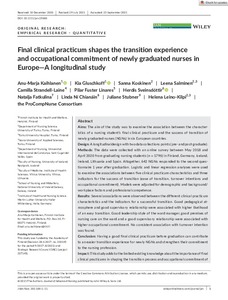Final clinical practicum shapes the transition experience and occupational commitment of newly graduated nurses in Europe—A longitudinal study
Ní Chianáin Linda; Koskinen Sanna; Sveinsdóttir Herdís; Stubner Juliane; Fatkulina Natalia; Kaihlanen Anu-Maria; Gluschkoff Kia; Leino-Kilpi Helena; the ProCompNurse Consortium; Strandell-Laine Camilla; Salminen Leena; Fuster Linares Pilar
https://urn.fi/URN:NBN:fi-fe2021102752656
Tiivistelmä
Aims: The aim of the study was to examine the association between the characteristics of a nursing student's final clinical practicum and the success of transition of newly graduated nurses (NGNs) in six European countries.
Design: A longitudinal design with two data collections points (pre- and post-graduate).
Methods: The data were collected with an online survey between May 2018 and April 2020 from graduating nursing students (n = 1796) in Finland, Germany, Iceland, Ireland, Lithuania and Spain. Altogether, 642 NGNs responded to the second questionnaire 1 year after graduation. Logistic and linear regression analyses were used to examine the associations between five clinical practicum characteristics and three indicators for the success of transition (ease of transition, turnover intentions and occupational commitment). Models were adjusted for demographic and background/workplace factors and professional competence.
Results: Several associations were observed between the different clinical practicum characteristics and the indicators for a successful transition. Good pedagogical atmosphere and good supervisory relationship were associated with higher likelihood of an easy transition. Good leadership style of the ward manager, good premises of nursing care on the ward and a good supervisory relationship were associated with higher occupational commitment. No consistent association with turnover intention was found.
Conclusion: Having a good final clinical practicum before graduation can contribute to an easier transition experience for newly NGNs and strengthen their commitment to the nursing profession.
Impact: This study adds to the limited existing knowledge about the importance of final clinical practicums in shaping the transition process and occupational commitment of NGNs. Investing in creating a good final practicum experience could help healthcare organizations engage new nursing professionals and thus alleviate the existing shortage of nurses.
Kokoelmat
- Rinnakkaistallenteet [19250]
